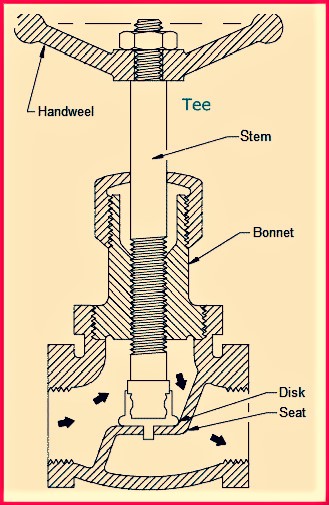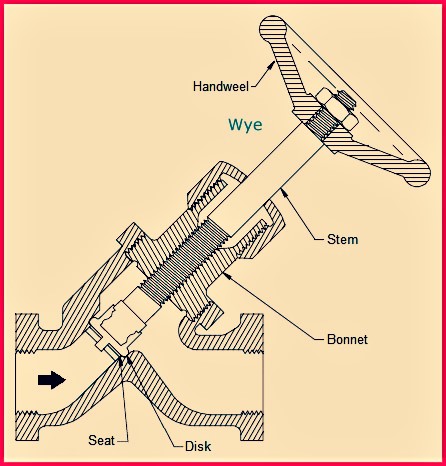In the Valves Part-1, you learned, What is a valve, its history and its categorization, to read that article please click here.
In this article, we will discuss about the valves categorized by design. The list follows as;
- Globe Valve
- Gate Valve
- Plug Valve
- Ball Valve
- Butterfly Valve
- Diaphragm Valve
- Pinch Valve
- Piston Valve
- Needle Valve
- Check Valve
- Relief & safety Valve
- Special Valve
In particular, this article is going to speak about Globe valves. History of valves was already discussed in Part-1 (Please click here to read part 1 of this article).
Globe Valves
Globe valve is a Linear Motion type of valves and is typically used in both On-Off and Throttling applications. In globe valves, the flow of the fluid through valve follows an S-path. Due to this, the flow direction changes twice which results in higher pressure drops. Due to other advantages offered by them, they are widely used in applications where pressure drop through the valve is not a controlling factor.
These valves are generally not used beyond sizes larger than DN 300 as enormous forces are exerted on the stem to open or close the valve under fluid pressures. Globe valves require high pressures on the seat to keep it closed when the fluid exerts pressure from the bottom of the disc.
The basic construction of Globe valve consists of Body, Bonnet, Seat, Disc, Stem & Handle.
Body is the main pressure containing structure of the valve and contains the valve’s internal parts that comes in contact with the working fluid.
Bonnet provides a leakproof closure for the valve body.
Seat ring provides uniform leak proof tightness. Usually bevelled to allow guiding during the final stage of closing.
Disk are closure member of the valve rests on the seat ring, connected to the stem which slide or screwed up or down to throttle the flow using a Handle.
Stem connects actuator/handle to the inside of the valve (disc) and transmits the actuation force. Stems are either smooth for actuator-controlled valves or threaded for manual valves.
There are three primary body designs for Globe valves, namely:
- Tee Pattern or Z-body
- Angle Pattern
- Wye Pattern or Y-body
1. Tee Pattern Globe valves: Tee Pattern Globe valves (Figure 1) are the most common body type, with a Z-shaped diaphragm. The horizontal setting of the seat allows the stem and disk to travel perpendicular to the horizontal line. This design has the lowest coefficient of flow and higher pressure drop. They are used in severe throttling services, such as in bypass lines around a control valve. Tee-pattern Globe valves may also be used in applications where pressure drop is not a concern and throttling are required.
Figure 1 (Tee Pattern Globe valve)
2. Angle Pattern Glove Valves: Angle Pattern Globe valves (Figure 2) are modified basic Tee Pattern Globe valve. The ends of this Globe valve are at an angle of 90 degrees, and fluid flow occurs with a single 90 degrees turn. They have a slightly lower coefficient of flow than wye-pattern Globe valves. They are used in applications that have periods of pulsating flow because of their capability to handle the slugging effect of this type of flow.
Figure 2 (Angle Pattern Globe valve)
3. Wye Pattern Globe valves: Wye Pattern Globe valves (Figure 3) is an alternative for the high pressure drop, inherent in Globe valves. Seat and stem are angled at approximately 45 degrees, what gives a straighter flow path at full opening and offer the least resistance to flow. They can be cracked open for long periods without severe erosion. They are extensively used for throttling during seasonal or start-up operations. They can be rod through to remove debris when used in drain lines that are normally closed.
Figure 3 (Wye Pattern Globe valve)
Click here to read the next part of this article.
This article is written and published by
Mr. Goutham Rathinam
(BE-Mechanical, CSWIP 3.1-TWI,UK)
Email ID: goutham.r86@gmail.com




